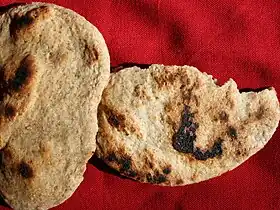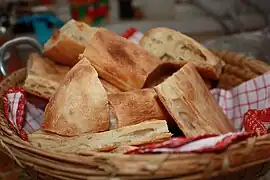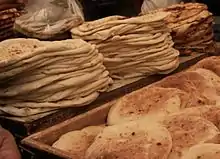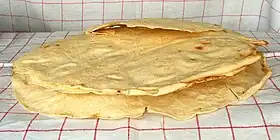Pain plat
Un pain plat est un pain fait avec de la farine, de l'eau et du sel, puis complètement roulé en une pâte aplatie. De nombreux pains plats sont sans levain, bien que certains soient au levain, comme la pizza et le pain pita.
| Pain plat | |

| |
| Ingrédients | Farine, eau, sel |
|---|---|
Les pains plats vont de moins d'un millimètre à quelques centimètres d'épaisseur afin qu'ils puissent être facilement mangés sans être tranchés. Ils peuvent être cuits au four, frits dans de l'huile, grillés sur des charbons ardents, cuits sur une poêle, tava, comal ou plaque de cuisson en métal. Ils peuvent être consommés frais ou emballés et congelés pour une utilisation ultérieure.
Histoire
En 2018, des miettes de pain carbonisées sont trouvées sur un site datant du natoufien appelé Shubayqa 1 en Jordanie (à Harrat ash Shaam). Ils datent de 12400 av. J.-C., environ 4 000 ans avant le début de l'agriculture dans la région. Leur analyse révèle qu'ils proviennent probablement de pains plats contenant de l'orge commune, du blé épineux, de l'avoine et des tubercules Bolboschoenus glaucus (une sorte de jonc)[1] - [2].
Liste de types de pains plats
Europe
- Bannique (Écosse)
- Blini (Russie)
- Bolo do caco (Madère, Portugal)
- Borlengo (Italie)
- Covaccino (Italie)
- Crescentina modenese (Italie)
- Farl (Irlande et Écosse)
- Flatbrød (Norvège)
- Flatkaka (Islande)
- Focaccia (Italie)
- Ftira għawdxija (Malte)
- Hoggan (Cornwall)
- Hönökaka (Bohuslän)
- Lagana (Grèce)
- Lefse (Norvège)
- Lepinja (Croatie, Serbie)
- Lepyoshka (Russie)
- Lipie (Roumanie)
- Oatcake (Royaume-Uni)
- Oatcake Staffordshire (Angleterre)
- Pane carasau (Sardaigne)
- Pastetx (France)
- Piadina (Italie)
- Pita (Grèce et Hongrie)
- Pain polaire (Suède)
- Pissaladière (France)
- Pizza (Italie)
- Podpłomyk (Pologne)
- Posúch (Slovaquie)
- Părlenka (Bulgarie)
- Rieska (Finlande)
- Somun (Bosnie-Herzégovine)[3] - [4]
- Spianata sarda (Sardaigne)
- Talo (France)
- Tarte flambée (Alsace)
- Torta (Espagne)
- Torta de gaspacho (Espagne)
- Torta al testo (Ombrie, Italie)
Moyen-Orient et Afrique


- Barbari (Iran)
- Bataw (Égypte)
- Bazlama (Turquie)
- Chapati (Zanguebar, Ouganda)
- Eish merahrah (Égypte)
- Gözleme (Turquie)
- Gurassa (Soudan)
- Harcha (Maroc)
- Injera (Corne de l'Afrique)
- Kesra (Algérie)
- Khobz soltani (Algérie)
- Khubz (Levant et Arabie)
- Khubz al-jamri (Arabie)
- Khubz asmr (Arabie)
- Kissra (Soudan)
- Lahoh (nord de la Somalie, Djibouti, Yémen)
- Lavash (Arménie)
- Maluj (Yémen)
- Marqouq (Levant)
- Matloue (Algérie)
- Matnakash (Arménie)
- Matza (Israël)
- Msemmen (Algérie, Tunisie)
- Mulawah (Yémen)
- Murr (Israël)
- Muufo (Somalie)
- Ngome (Mali)
- Pain saj (Liban, Turquie, Israël)
- Pita (Méditerranée orientale, Turquie et Moyen-Orient)
- Pogača (Balkans et Turquie)
- Sangak (Iran)
- Shotis puri (Géorgie)
- Taftan (Iran)
- Tonis puri (Géorgie)
- Yufka (Turquie)
Asie centrale

- Bolani (Afghanistan)
- Obi non (Afghanistan et Ouzbékistan)[5]
- Pain afghan ou nan (Afghanistan)
- Pain tandoori (Asie centrale)
- Shelpek (Kazakhstan)
- Tapansha, taba nan (Kazakhstan)
Asie de l'Est
- Bindaeddeok (Corée)
- Bing (Chine)
- Cong you bing (Chine)
- Laobing (Chine)
- Sanchuisanda (Chine)
- Shaobing (Chine)
Asie du Sud
- Aloo paratha (Inde et Pakistan)
- Akki rotti (Inde)
- Appam (Inde)
- Bakarkhani (Bangladesh)
- Bhakri (Inde)
- Bhatoora (sous-continent indien)
- Chapati (sous-continent indien)
- Chili parotha (Inde)
- Chikkolee (Inde)
- Dhebra (Inde)
- Dosa (Inde)
- Gobi paratha (Inde et Pakistan)
- Jolada rotti (Inde)
- Kalai roti (Bangladesh)
- Kaak (Pakistan)
- Kachori (sous-continent indien)
- Kothu parotta (Inde)
- Kulcha (sous-continent indien)
- Luchi (Inde et Bangladesh)
- Makki di roti (Inde et Pakistan)
- Mughlai paratha (Inde et Bangladesh)
- Pathiri (Inde)
- Naan (sous-continent indien et Asie centrale)
- Cheese naan (sous-continent indien)
- Naan Paratha (sous-continent indien)
- Paratha (sous-continent indien)
- Parotta (Inde et Sri Lanka)
- Pesarattu (Inde)
- Puran poli (Inde)
- Puri (sous-continent indien)
- Ragi rotti (Inde)
- Roti (sous-continent indien)
- Rumali roti (sous-continent indien)
- Sheermal (sous-continent indien et Iran)
- Taftan (sous-continent indien et Iran)
Asie du Sud-Est
- Aparon (Philippines)
- Bánh (Vietnam)
- Kabkab (Philippines)
- Khanom buang (Thaïlande)
- Kiping (Philippines)
- Piaya (Philippines)
- Roti canai (Indonésie et Malaisie)
- Roti prata (Singapour)
- Roti tissue (Indonésie et Malaisie)
Amériques

- Arepa (Colombie, Venezuela)
- Bammy (Jamaïque)
- Beiju (Brésil)
- Frybread (États-Unis)
- Johnny cake (Amérique du Nord et Caraïbes)
- Pain plat amérindien (Amérique du Nord)
- Pan de semita (Mexique)
- Pupusa (El Salvador)
- Tapioca (Amérique du Sud, Caraïbes)
- Tortilla (Mexique, Amérique centrale et du Sud)
- Tortilla de rescoldo (Chili)
Notes et références
- (en) Cet article est partiellement ou en totalité issu de l’article de Wikipédia en anglais intitulé « Flatbread » (voir la liste des auteurs).
- Colin Barras, « Stone Age bread predates farming », New Scientist, vol. 239, no 3187, , p. 6 (DOI 10.1016/S0262-4079(18)31274-0, Bibcode 2018NewSc.239....6B, lire en ligne).
- Amaia Arranz-Otaegui et al., « Archaeobotanical evidence reveals the origins of bread 14,400 years ago in northeastern Jordan », PNAS, vol. 115, no 31, , p. 7925-7930 (PMID 30012614, PMCID 6077754, DOI 10.1073/pnas.1801071115).
- Rodolfo Toe, « Sarajevo Bakery Braces for Ramadan Bonanza », sur balkaninsight.com, (consulté le ).
- Celjo, « Serbian crepes are just one reason to try Fabrika by Madera: SBS Food », sur sbs.com.au (consulté le ).
- (en) « The Fabled Flatbreads of Uzbekistan - AramcoWorld », sur aramcoworld.com (consulté le ).
Annexes
Bibliographie
- (en) « High-Profile Flatbreads - Say Goodbye to Insipid White Bread When Tortillas and Flatbreads Come to Town », Food Product Design - Northbrook, vol. 15, no 1, , p. 96-114.
- (en) « Flatbreads Old World: Meets New Flatbreads from All Over the World-Including Tortillas, Arepas and Naan-Are the Newest Hot Ticket in Both Retail and Foodservice Products », Food Product Design - Northbrook, vol. 18, no 11, , p. 38-43.
- (en) « Storied Breads: With a Continuing Focus on Food Origin, Flatbreads Offer Manufacturers a Way to Tempt Consumers with Authentic Products Celebrating the Oldest-Known Bread Traditions », Baking and Snack, vol. 30, no 7, , p. 35-42.
- (en) « Flat-Out in Love with Flatbread Here Are 5 Reasons Foodservice Is Smitten with Flatbreads », Food Management, vol. 46, no 11, , p. 30-35.
- (en) Jeffrey Alford, Flatbreads and flavors : a baker's atlas, Morrow, (ISBN 0-688-11411-3, 978-0-688-11411-4 et 978-0-06-167326-9, OCLC 30914481, lire en ligne).
- (en) Anne Craddock, Textural Characteristics of Bagels and Ethnic Flatbreads, Thèse, , 124 p.
- (en) Donna Rathmell German, Flatbreads from around the world, Bristol Pub, (ISBN 1-55867-097-1 et 978-1-55867-097-6, OCLC 31602069, lire en ligne).
- (en) Anissa Helou, Savory baking from the Mediterranean : focaccias, flatbreads, rusks, tarts, and other breads, William Morrow, (ISBN 0-06-054219-5 et 978-0-06-054219-1, OCLC 71508611, lire en ligne).
- (en) Talwinder Singh Kahlon et Mei-Chen Maggie Chiu, « Ancient Whole Grain Gluten-Free Flatbreads », Food and Nutrition Sciences, vol. 5, no 17, , p. 1717-1724 (ISSN 2157-944X et 2157-9458, DOI 10.4236/fns.2014.517185, lire en ligne, consulté le ).
Liens externes
- Notice dans un dictionnaire ou une encyclopédie généraliste :


